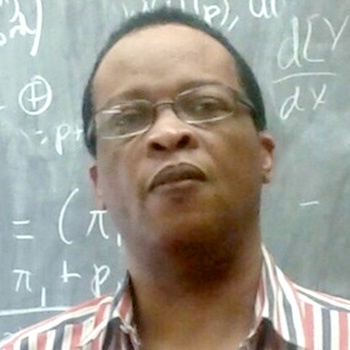This was a very productive year. The teaching was very stimulating. I had the opportunity to work with some very good African American students. My research went very well. I submitted one paper for publication, and I am about to complete another. I express my deepest gratitude to the MLK Visiting Professorship Program at MIT and to David Vogan, chairman of the Mathematics Department, for allowing me to be part of the Program.
Background
Alfred G. Noel is a lecturer in mathematics, computer science and biostatistics at Northeastern University. Noel holds a BET in electrical engineering from the Centre Pilote de Formation Technique in Port-au-Prince, Haiti. He earned a mathematics high school teacher certificate at the Institut Pédagogique National in Port-au-Prince, Haiti. Noel went on to earn an MSc in applied mathematics (1986) and a PhD in pure mathematics (1997).
Interests
Noel’s research focuses on representation theory of lie groups using a combination of classical and computational techniques as well as mathematics education. He worked as a senior software engineer at Computervision and a research engineer at Peritus Software before joining the faculty at Northeastern in 1984. Noel gives lectures at national and international conferences worldwide (France, Spain, Poland, Russia, China, Japan, Singapore). He is a member of the American Mathematical Society and the National Association of Mathematicians. Since 1996 he has organized a seminar series for the Haitian Scientific Society, of which he is a founding member.
As a 2000-2001 MLK Scholar at MIT, Noel was hosted by the Department of Mathematics, where he taught a course in linear algebra and conducted research, resulting in two papers in the American Mathematical Society Journal of Representation Theory.
Sample Work
Publication
Classification of Admissible Nilpotent Orbits in Simple Exceptional Lie Algebras of Type E6(6) and E6(-26)
Classification of Admissible Nilpotent Orbits in Simple Exceptional Lie Algebras of Type E6(6) and E6(-26) American Mathematical Society Journal of Representation Theory, Volume 5 (494-502) 2001.
Publication
Classification of Admissible Nilpotent Orbits in Simple Exceptional Lie Algebras of Inner Type
Classification of Admissible Nilpotent Orbits in Simple Exceptional Lie Algebras of Inner Type. American Mathematical Society Journal of Representation Theory, Volume 5 (455-493) 2001.
Publication
Component Groups of Centralizers of Nilpotents in Symmetric Space
Component Groups of Centralizers of Nilpotents in Symmetric Space. Co-author Donald R. King. Journal of Algebra Vol 232 (94-125) 2000.
Publication
Nilpotent Orbits and Theta-stable Parabolic Subalgebras
Nilpotent Orbits and Theta-stable Parabolic Subalgebras. American Mathematical Society Journal of Representation Theory, Volume 2 (1-32) 1998.

